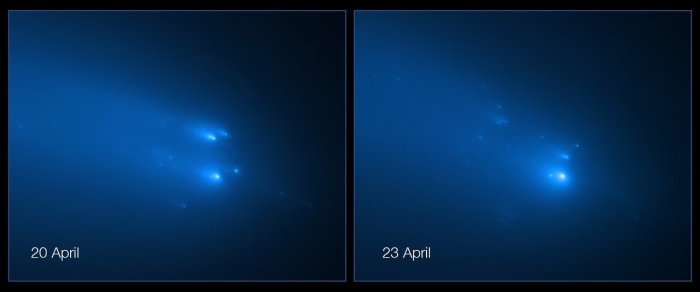Products You May Like
A comet only just discovered in December of last year has already met its demise. It didn’t reach perihelion, or its closest approach to the Sun. It didn’t even pass inside Earth orbit. Yet Comet C/2019 Y4 (ATLAS) has now absolutely shattered.
In images taken on April 20 and April 23, the Hubble Space Telescope has captured at least 30 and 25 fragments of the comet respectively, travelling together in a cluster as they continue towards the inner Solar System.
“Their appearance changes substantially between the two days, so much so that it’s quite difficult to connect the dots,” said astronomer David Jewitt of the University of California, Los Angeles.
“I don’t know whether this is because the individual pieces are flashing on and off as they reflect sunlight, acting like twinkling lights on a Christmas tree, or because different fragments appear on different days.”
The fragmentation of C/2019 Y4 (ATLAS) has quite dashed hopes that the comet would be visible to the naked eye from Earth, even in daylight. But, although it’s not uncommon for comets to shatter as they near the Sun, catching one in the act in such spectacular detail is rare.
“This is really exciting – both because such events are super cool to watch and because they do not happen very often. Most comets that fragment are too dim to see,” said astronomer Quanzhi Ye, of the University of Maryland.
“Events at such scale only happen once or twice a decade.”
Hubble has managed to resolve individual pieces of the comet – thought to be originally up to 200 metres (650 feet) across – as small as the size of a house, from a distance of 145 million kilometres (90 million miles).
And those chunks could provide clues as to the mechanism behind the fragmentation of these peripatetic chunks of ice and rock – a process we still don’t fully understand.
We think it has to do with the sublimation of cometary ices, as the comet nears and is warmed by the Sun. This outgassing produces the classic comet halo and tail. But, as those gases leave the comet, they can act as a sort of jet, propelling the comet to spin.
If this spin becomes fast enough, centripetal forces could exceed the material strength of the nucleus to the extent that the comet splits and fragments under the stress.
 (NASA, ESA, D. Jewitt/UCLA, Q. Ye/University of Maryland)
(NASA, ESA, D. Jewitt/UCLA, Q. Ye/University of Maryland)
“Further analysis of the Hubble data might be able to show whether or not this mechanism is responsible,” Jewitt said.
We’ll also have more opportunities to study the shattered comet, which is still on an inbound trajectory. Currently, it’s inside the orbit of Mars, and is yet to pass Earth orbit; at its current velocity, the comet will do so at a distance of 115 million kilometres (71 million miles) from Earth on May 23.
From there, it will continue towards the Sun, scooping in as close as 37 million kilometres (23 million miles) on May 31 – well within Mercury’s average orbit of 57.9 million kilometres (36 million miles).
And from there, the pieces will disappear back into the far reaches of the Solar System on their looping, 6,000-year orbit around the Sun, and we’ll never see them again in our lifetimes.
Astronomers will, of course, take the opportunity to continue to monitor the cloud with whatever telescopes are available to observe how it changes and to try to find more clues about how comets shatter.
“Regardless,” Jewitt said, “it’s quite special to get a look with Hubble at this dying comet.”
